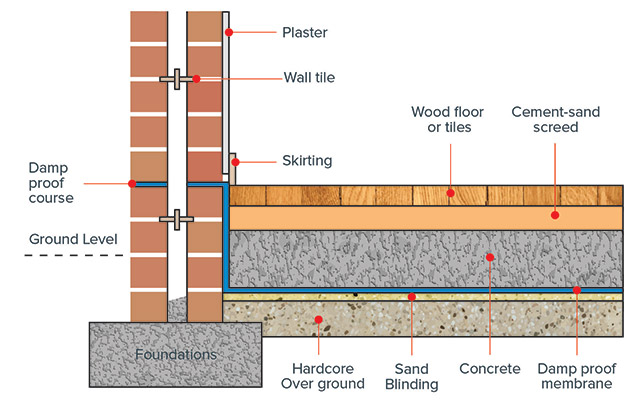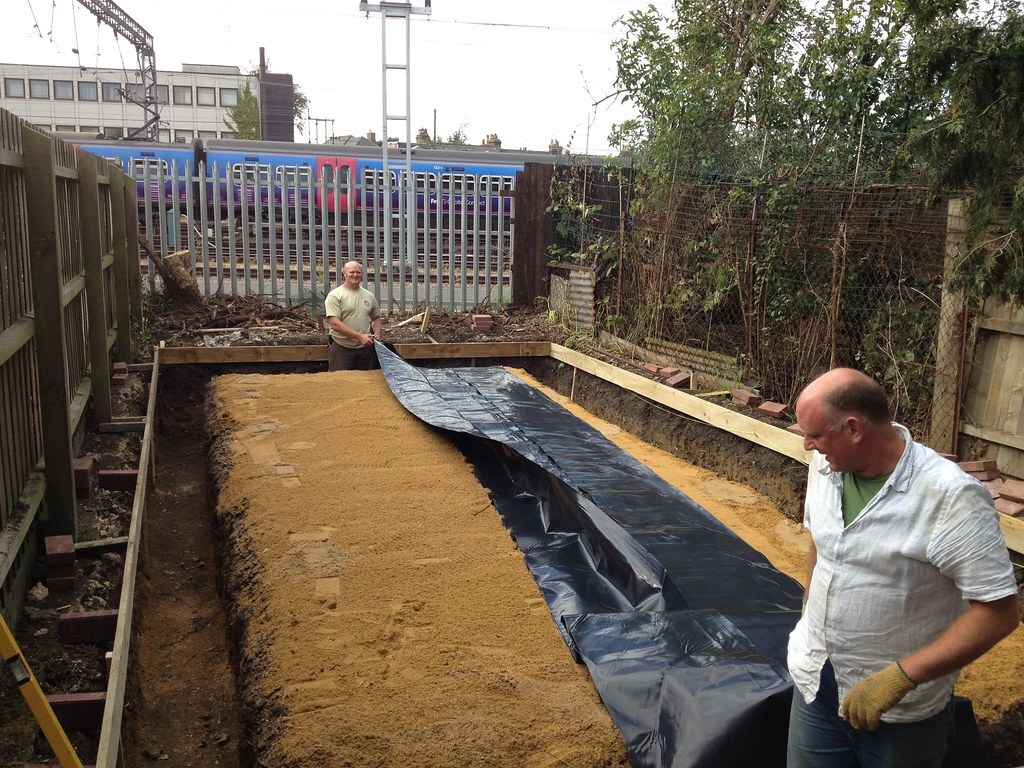Checking Out the Different Strategies and Solutions for Effective Damp Proofing
Dampness in buildings postures considerable obstacles to both structural integrity and interior air top quality. Various strategies and solutions have actually arised to battle this prevalent concern. From standard damp-proof membrane layers to innovative chemical therapies, each method supplies special advantages. Recognizing these options is vital for reliable moisture control. Picking the best service depends on specific structure conditions and needs, motivating more expedition right into the most efficient moist proofing approaches available.
Comprehending the Reasons For Dampness
Moisture can occur from numerous resources, understanding these reasons is vital for reliable removal. Generally, dampness stems from three main sources: rising moist, passing through moist, and condensation. Climbing damp occurs when groundwater takes a trip up-wards with porous materials, such as brick or rock, commonly because of a lack of an efficient obstacle (mould removal newcastle). Passing through moist is generally triggered by external aspects, consisting of roofing leaks, malfunctioning gutters, or damaged wall surfaces, allowing water to infiltrate a home. Condensation, on the various other hand, arises from excess wetness airborne, often exacerbated by poor air flow and temperature level differences, causing water droplets basing on surfaces. Identifying these underlying problems is vital, as each kind of wetness calls for a customized approach for remediation. Appropriate analysis assists in determining the most reliable remedies, ultimately protecting the architectural stability of a building and improving interior air quality
Conventional Damp-Proof Membrane Layers

Chemical Damp-Proofing Solutions
Chemical damp-proofing solutions supply a cutting-edge strategy to avoiding moisture intrusion in structures. These techniques normally include the application of liquid chemicals that pass through masonry and create an obstacle versus climbing damp. Generally utilized chemicals include silanes, siloxanes, and various other water-repellent representatives that respond with surface area materials to create a hydrophobic layer.The application process generally calls for exploration openings into the walls, infusing the chemical remedy, and permitting it to heal. This method is especially useful for older frameworks where conventional damp-proof membrane layers might be not practical. Chemical damp-proofing can be much less turbulent and more cost-effective than extensive improvement projects.While reliable, these solutions depend on correct application and environmental problems for peak performance. mould removal newcastle. Routine maintenance and tracking are necessary to assure the long life of the damp-proofing treatment. Generally, chemical damp-proofing represents a functional choice for protecting buildings versus moisture-related damages
Dental Caries Wall Surface Construction Methods
Tooth cavity wall surface building and construction strategies offer many benefits, especially in dampness control and energy performance. By incorporating an air space in between two layers of stonework, these wall surfaces properly mitigate water access while enhancing insulation. This mix not just secures frameworks from wetness but also adds to reduced power usage.
Benefits of Cavity Walls
When taking into consideration efficient wet proofing approaches, the advantages of tooth cavity walls attract attention prominently. Dental caries wall surfaces are composed of two different layers, producing an air gap that properly minimizes wetness infiltration. This layout reduces the risk of wetness, as the outer wall surface acts as an obstacle versus rain and water access. In addition, cavity wall surfaces boost thermal insulation, which adds to power performance by decreasing warm loss. They likewise give sound insulation, assisting to develop a quieter indoor environment. The air gap allows for air flow, which helps in moisture control and minimizes the chance of mold and mildew growth. These advantages not just enhance the general convenience of a building but likewise add to its long life and structural integrity.
Moisture Control Methods
Efficient wetness control strategies are vital in dental caries wall surface construction to guarantee lasting security versus dampness. One key technique entails the consolidation of weep holes, which facilitate water drain from the dental caries, protecting against buildup. In addition, the use of breathable membranes can assist handle wetness degrees while allowing entraped vapor to leave. Proper placement of insulation is likewise critical, as it must not obstruct drainage courses. Making sure that the external leaves of the dental caries wall are constructed with water-resistant materials improves overall durability. Regular upkeep checks are necessary to recognize any obstructions or damage early, securing the framework's honesty. Inevitably, a mix of these techniques develops a robust defense against moisture intrusion in tooth cavity walls.
Insulation and Power Effectiveness
Insulation plays an essential role in improving power performance within dental caries wall surface building. By incorporating shielding products, these wall surfaces develop a thermal obstacle that reduces warm loss and minimizes energy consumption. Reliable insulation not only aids preserve a secure interior temperature yet likewise alleviates the risk of moisture, as it stops condensation within the wall cavity. Various techniques, such as making use of stiff foam boards or mineral woollen, can be used to attain excellent insulation efficiency. In addition, proper installation is important to guarantee that spaces and spaces are lessened, which can or else compromise energy effectiveness. Ultimately, a well-insulated dental caries wall surface adds substantially to total sustainability and decreases heating and cooling expenses for homeowners.
Outside Damp Proofing Approaches
Exterior damp proofing methods are necessary for securing structures from wetness seepage. 2 effective strategies include the application of waterproof membrane layers and the installment of French drains. These remedies help mitigate water buildup and preserve the stability of structures.
Waterproof Membrane Application
While different approaches exist for stopping moisture access, the application of water-proof membranes stays an extremely reliable exterior moist proofing technique. These membranes are commonly made from products such as polyethylene, rubber, or modified bitumen, offering a robust barrier against water infiltration. The setup process involves applying the membrane to the outside surface areas of walls or foundations, making certain total insurance coverage to avoid leakages. Appropriate adhesion and securing at joints are important to making best use of efficiency. Water-proof membrane layers can be applied in numerous forms, consisting of liquid finishes and sheet membrane layers, permitting for flexibility based on the particular needs of the structure. This method not just shields buildings from dampness yet also improves their durability and architectural integrity.
French Drain Installation
One effective technique for managing groundwater and preventing wetness buildup around a structure's structure is the installation of a French drain. This drain system contains a trench filled with gravel and a perforated pipeline that reroutes surface water away from the structure. Correct setup requires careful planning, guaranteeing that the drain slopes away from the structure to assist in suitable water circulation. Furthermore, the place of the drainpipe is essential; it should be placed in locations susceptible to pooling or excess wetness. Regular maintenance, consisting of clearing up debris from the gravel and ensuring the pipeline remains unhampered, is essential for long-lasting effectiveness. Ultimately, a well-installed French drainpipe can significantly lower the threat of water-related issues in basements and structures.
Inside Waterproofing Approaches
Inside waterproofing techniques are crucial for protecting a building's interior from wetness seepage and possible water damage. These methods typically involve the application of specific materials and strategies made to produce a moisture obstacle within the framework. One common approach is making use of water-proof finishings or sealers on wall surfaces and floors, which avoid moisture from penetrating surfaces.Additionally, setting up indoor drainage systems, such as sump pumps, can effectively manage water buildup in cellars and creep areas. Another approach includes the usage of vapor obstacles, which are mounted to prevent moisture movement from the ground into living spaces.Moreover, attending to any type of fractures or gaps in walls or structures with proper sealers assures a comprehensive protection against water intrusion. By applying these interior waterproofing strategies, building proprietors can considerably decrease the danger of mold development, structural damage, and other moisture-related problems. Appropriate implementation of these techniques is vital for long-lasting protection and structure honesty.
Normal Maintenance and Assessment Practices
Routine upkeep and examination techniques are vital for assuring the long-lasting performance of moist proofing solutions in any kind of building. Routine checks make it possible for homeowner to recognize very early indicators of moisture invasion, such as peeling off paint, mold growth, and musty odors. These indications can signal underlying issues that need immediate attention.Inspections ought to be conducted at the very least every year, concentrating on vulnerable areas like basements, crawl rooms, and outside walls. Throughout these evaluations, residential or commercial property owners ought to take a look at sealants, drain systems, and ventilation to verify they work correctly.Additionally, maintaining seamless gutters and downspouts is important, as clogged up systems can lead to water build-up near the foundation. Executing a normal check here maintenance routine, in addition to prompt repairs, can significantly extend the lifespan of damp proofing procedures and shield the architectural integrity of the building. Proactive steps ultimately contribute to the total health and wellness of the living setting.
Often Asked Questions
How Lengthy Does Damp Proofing Normally Last?
The duration of damp proofing performance differs, usually lasting between 20 to half a century. Variables such as application quality, environmental problems, and maintenance methods greatly influence the long life of the damp proofing treatment.

Can I Damp Proof My Home Myself?
The individual pondered the feasibility of do it yourself damp proofing. With proper study and the best materials, it is feasible. They likewise acknowledged the relevance of expert advice to ensure long-lasting effectiveness and avoid future concerns.
What Are the Signs of Inefficient Damp Proofing?
Indications of inefficient moist proofing include relentless musty odors, visible mold and mildew growth, peeling paint, moist spots on wall surfaces, and timber decay - mould removal newcastle. Home owners must deal with these concerns promptly to avoid further damages and wellness worries
Does Damp Proofing Affect Indoor Air High Quality?

Just How Much Does Specialist Damp Proofing Expense?
Specialist damp proofing prices differ considerably, usually ranging from $1,000 to $5,000 depending on the residential property's dimension, the degree of the damp issue, and picked methods. Each scenario calls for a tailored evaluation for precise rates. Typically, moisture stems from three key sources: rising wet, permeating damp, and condensation. When considering reliable damp proofing approaches, the advantages of tooth cavity walls stand out prominently. Outside damp proofing techniques are vital for safeguarding frameworks from dampness infiltration. While numerous techniques exist for stopping wetness access, the application of water-proof membrane layers stays a highly efficient outside wet proofing method. Indicators of ineffective damp proofing consist of consistent musty odors, visible mold and mildew growth, peeling off paint, damp patches on walls, and wood degeneration.